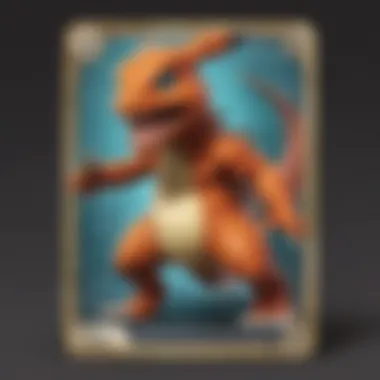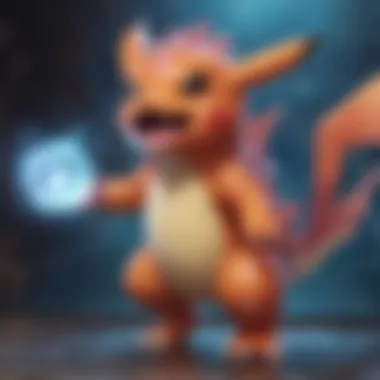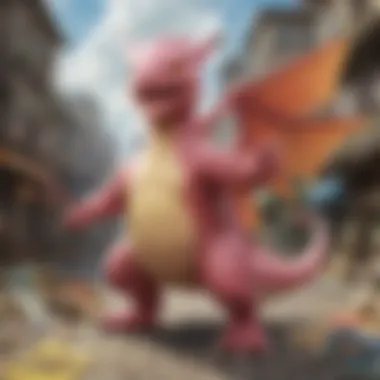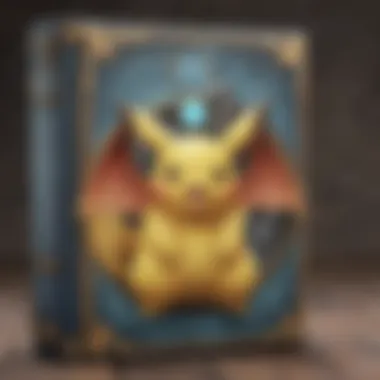Discovering Top Pokémon Cards for Collectors & Players


Intro
The world of Pokémon cards offers a rich tapestry for both collectors and players. With a historical legacy that spans over two decades, Pokémon cards capture not just playful game mechanics, but also strategic craftsmanship and collectibles allure. The rise in the popularity of Pokémon cards has transformed the market significantly. When motivated by profound personal interests or investment, knowing what to buy significantly enhances your experience.
In this article, we will explore which Pokémon cards represent the best value for acquisition. Various categories of cards will be examined, from standard to promotional. Furthermore, we will analyze current market trends and share tips for smart purchasing. Understanding these aspects will certainly help in making informed decisions when looking to enhance your collection or bolster your gameplay competitive edge.
Pokemon Game Overview
History of Pokémon Games
Since the debut of Pokémon Red and Green in 1996 (1998 in North America), the franchise has undergone major advancements. The core gameplay influenced generations and created a culture echo here today. Starting as an adventure of capturing Creatures in pixelated graphics, Pokémon has transformed with multi-dimensional gameplay, new storylines, and richer worlds.
Evolution of Gameplay Mechanics
The rules of Pokémon games evolved significantly. Early games focused on turn-based mechanics. As franchise expanded, complex features, like Mega Evolution, Dynamaxing, and unique battle abilities emerged, adding strategy. These renovations ensured each title offered much depth yet appealing access for new players.
Prelude to Different Game Versions
Fans could pick Pokémon titles from various options, aligning to preferences. Sinnoh Region introduced contests; Alola included trials instead of gyms. The expansions brought diverse gameplay, which often segued into thoughts on Pokémon cards within these universes, showcasing parallel developments in the card game as well.
Tips and Strategies
Beginner's Guide to Pokémon Cards
Starting in Pokémon is exciting yet could feel overwhelming. This section targets novice collectors or players eager to learn.
- Research Card Value: Websites sell pricing trends. Familiarity allows negotiating for a better deal when collecting.
- Focus on Sets: Instead of random purchases, explore complete sets, as they often unlock bonus values.
- Know Common Cards: Getting aware of common versus rare cards models basic understanding of card hierarchy.
Advanced Gameplay Tactics
Those with experience should explore advanced layers of Pokémon gameplay mechanics. Learning optimal strategies will improve success rates, both for collecting and playing developers. Skills include battling techniques and trading value evaluation.
Team Building Strategies
Collecting cards does not solely involve hunting for rare pieces. Constructing an optimal team is crucial in competitive gameplay:
- Diversity is Key: Creating a balanced team icludes choosing different types to counter varying matchups.
- Consider Practices: Experiment to discover which Pokémon effectively synergize during battles, amplifying stats and turn order.
Character Spotlights
Featured Pokémon Profiles
Let’s highlight some profound pkmn characters impacting the gameplay and card realm:
- Pikachu: As mascot, suitable for all players, pervasive across sets and timelines.
- Charizard: Long-time favorite revered for impressive lore and amazing cards, particularly 1st edition variations.
Analysis of Popular Characters
Certain Pokémon amassed gorgeous admirer bases, founded migratory strategies situated on their inherent advantages or creativity in gameplay style. Understanding their strengths validates advanageous tactics or collection integrity.
Impact of Characters on Gameplay
Each character encapsulates unique traits calling meant for strategic deployment within any mosaics across card tiers.
Latest News and Updates
Recent Game Releases
The Pokémon Company continues innovating. Visit en.wikipedia.org to find updated inormation about latest titles introduced to gameplay.
Patch Updates and Events
Regular patche notate adjustments that affect both gameplay and card utilization. Increasing experience takes diligent following of change logs and event interactions.


Rumors and Speculations
Every feature linked to Pokémon game sparkles intent; sporadic news reports leave enthusiasts question factors determining future the development. Regular monotoring - possibly through social networks like reddit.com and facebook.com grants an edge towards understanding potential gameplay evolutions.
As venture forth within Pokémon realms, embrace the strategies, skills, and lore that each review enriches in mind.
Prelude to Pokémon Cards
The world of Pokémon cards represents an enduring brand that has captivated many individuals across ages. *Fundamentally, Pokémon cards are more than just collectibles; they serve as a gateway into a vast universe that combines nostalgia, strategic gameplay, and community engagement.
Understanding Pokémon cards contributes immensely to this article, especially in terms of gathering relevant knowledge for potential buyers or serious collectors. For instance, familiarizing oneself with the history, types, and value of the cards can significantly enhance one’s ability to make informed decisions. Furthermore, it builds the foundation for appreciating various sets that have marked their place in the Pokémon card realm.
History of Pokémon Cards
The inception of Pokémon trading card game can be traced back to 1996, when it was first released in Japan. Created by Satoshi Tajiri and Ken Sugimori, it began as a simple trading activity for youngsters. The game gained immense popularity and garnered widespread attention, leading to an expansion around the world. By 1999, Pokémon cards entered the Western market, welcoming fans to engage in card battles and trades.
This rich history is critical when evaluating card significance today. Over the years, many cards have been discontinued, discontinued or have undergone redesigns, which has heightened their desirability among collectors. Many players now consider older cards as integral pieces of their strategy that symbolize their experience in the game.
The Evolution of Card Rarity
Rarity amongst Pokémon cards has gone through notable changes since their introduction. Initially, every card type was perceived similarly, offering players equal opportunity to acquire powerful supporters for their decks. However, as the game matured, so did the designs and card functionalities, resulting in varied rarity among them.
- Introduction of Types: First comments pertained to the regular, uncommon, and rare classifications. This structure has seen growth since.
- Special Editions: Cards such as the holographic Charizard have become infamous for their scarcity and must-have status among collectors.
- Ultra Rare Examples: Several variations have emerged, including Full Art and Secret Rare cards that command further interest and investment.
This landscape of card rarity is markedly pertinent in the present Pokémon card market. An astute understanding of these shifting dynamics not only enhances collection value but guides purchasing strategies among enthusiasts and investors.
Understanding Card Types
Understanding different types of Pokémon cards is crucial for both collectors and players. Each category offers a unique function and appeal. Familiarity with card types allows one to make strategic choices in gameplay, optimizing decks with the right cards. Additionally, collectors who identify rare or valuable cards typically delve into card types, seeking specific variants to enhance their collections. Moreover, knowledge of these categorizes helps in setting realistic purchase expectations as certain types hold different market values.
Basic Pokémon Cards
Basic Pokémon cards serve as the foundation of any deck. They are the first step for players to build their combat strategies. Unlike other cards, Basic Pokémon can be played directly onto the field without any prior evolution. Having robust Basic Pokémon often creates a strong starting point in battles, as these cards can directly deal damage. For serious collectors, older or rare Basic Pokémon cards such as the original Pikachu have considerable value, potentially gaining over time as interest in older cards surges.
Stage and Stage Pokémon Cards
Stage 1 and Stage 2 Pokémon cards represent evolved forms. Stage 1 cards evolve from Basic Pokémon and add depth to a player's strategy. They often possess higher stats and more powerful abilities. Stage 2 cards evolve from Stage 1 variants; thus, they are typically stronger and can sway the outcome of many duels. For collectors, these evolutionary cards can anchor a thematic collection or depict moments of progression—statements of growth within the Pokémon journey.
EX, GX, and Cards
EX, GX, and V cards come with more advanced abilities and higher HP, providing significant advantages in battles. These cards often showcase popular Pokémon in hyper-realistic images, making them attractive to collectors. Their unique mechanics (like having powerful attacks or effects) enhance gameplay depth. Although these cards are typically more expensive and sought after, for enthusiasts, they represent the synthesis of aesthetics and competitive ingenuity. They can become central to many successful deck strategies, thereby impacting market values significantly.
Full Art and Secret Rare Cards
Full Art and Secret Rare cards often entice collectors. Their design extends beyond traditional dimensions, showcasing vivid artwork that attracts instant admiration. Secret Rare cards include limited-issue graphic designs that either faintly obscure their rarity or have special design traits, making them desirable treasures to pursue. Collectors prize these cards not just based on gameplay but more on their rarity, requiring specific opportunities to acquire them.
“Full Art and Secret Rare cards showcase the pinnacle of collection strategy. They blend artistry with rare design.”
Understanding these card types helps tragically position well when deciding to buy or collect Pokémon cards, leveraging the variety available in today's market.
Evaluating Card Value
Understanding the market value of Pokémon cards is crucial for both collectors and players. The value of a card does not solely depend on its character or rarity; it is influenced by a confluence of factors that strongly impact buying decisions. This section evaluates the elements that play a role in card pricing.
Factors Impacting Card Prices
Several specific factors directly influence the prices of Pokémon cards:
- Rarity: The more rare a card is, the higher its market value. Cards from older sets or limited print runs typically command a higher price.
- Condition: Card condition can vary greatly, which significantly impacts value. Cards graded by professional services, like PSA or Beckett, are often priced higher than ungraded options.
- Demand: Just like in any market, high demand can drive up prices. Trending Pokémon characters can cause spikes in pricing.
- Historical Significance: Cards that have played a significant role in the game's history, like the original Pikachu, tend to fetch higher prices due to their nostalgia factor.
All of these elements contribute to the complex dynamic of Pokémon card pricing.
Market Trends and Their Influence


Investors and collectors should pay attention to the ongoing trends within the Pokémon card market. Various patterns have emerged over the years that can guide purchasing decisions.
- Popularity Cycles: New Pokémon games or series can rejuvenate interest in specific cards. For instance, the release of new video games often boosts prices of associated cards from older sets.
- Community Influence: Online communities, especially forums like Reddit or Facebook groups, often discuss and drive up interest in selected cards. This can cause sudden surges in value based on shared sentiments.
- Economic Factors: General economic conditions can also impact buying power. During a financial downturn, collectors may be less inclined or able to spend on premium cards.
Keeping an eye on these trends can help collectors make informed decision and avoid unforeseen losses.
In summary, understanding both the specific factors and broader market trends will enhance one’s ability to evaluate the value of Pokémon cards effectively.
Top Pokémon Cards to Consider
When selecting Pokémon cards, understanding what type of cards have high value and relevance can greatly enhance your collection. The following sections explore different categories of cards that currently capture attention in the Pokémon community. Each category has its own significance and appeal, often influenced by nostalgia, rarity, and play utility.
Legendary Cards
Legendary cards often hold a special place among collectors and players alike. These cards are typically representative of powerful Pokémon that are iconic within the lore, such as Mewtwo and Rayquaza. Their value tends to rise due to limited print runs and competitive viability. Positive attributes of legendary cards include:
- High Rarity: Many legendary cards are exceptionally rare, often produced in smaller quantities compared to regular sets.
- Collectible Status: Due to their significance in the Pokémon series, collectors seek these cards to complete their sets or as prized possessions.
- Competitive Edge: Some legendary cards boast superior abilities, making them sought after in gameplay.
When considering legendary cards, check their condition, such as whether they are still in mint state. This can directly influence their market price.
Starter Pokémon Cards
Starter Pokémon cards represent the initial Pokémon choices from various generations. Examples include Charizard from the Base Set or Raichu from promo sets. They often evoke nostalgia among fans who began their journeys with these characters. Points to regard about starter cards include:
- Appeal to Emotion: Many collectors start with isue which can guid their choice later on.
- Versatile Playability: As beginners, starter Pokémon are generally easier for new players to use effectively, expanding their audience.
- Potential Value Growth: Over time, certain starter cards can appreciate significantly in value, making them wise investments.
It's wise to monitor the condition, as scratches or bends can diminish value over time.
Trainer Cards
Within player strategy, trainer cards play diviating roles in enhancing gameplay. Trainer cards allow players to manipulate game mechanics by providing tools, supporters, and items. They serve significant benefits like:
- Strategic Depth: Trainer cards contribute valuable options during exchanges, building synergies with Pokémon.
- Commander Role: Many of them facilitate game flow, allowing players to set up combinations more effectively.
- Collectible Variants: Specialty trainer cards or icons often drive collectors to seek certain images or supporting features.
Focus on those trainers having distinct abilities, as these are more likely to hold long-term interest, thus increasing their value.
Rare Event Cards
Finally, rare event cards often stem from one-off tournaments or pre-release celebrations. The distinctiveness of these cards garners attention due to their exclusiveness. Important attributes include:
- Unique Art and Design: Rare cards frequently boast striking art p heaturing a same character procreating smiles of it anyway.
- Limited Availability: Their transient nature spurs demand because printed runs are not more commonplace compared to other kinds of Pokémon cards.
- Enhanced Value: The intersections between exlusive events and nostalgia significantly influece price, thus offering compelling options for both sellers and buyers.
Stay cautious when navigating markets for event cards—check back for the latest releases, thus avoiding scams that can occur with fakes.
Collectors need to engage in due diligence when considering Pokémon cards of varied types. Knowledge shapes value and appreciation.
Where to Buy Pokémon Cards
Finding the right sources to buy Pokémon cards is essential for both collectors and players. Each option has its traits and drawbacks, impacting overall experience and acquisition options. This section examines key avenues where you can find Pokémon cards and discusses benefits, considerations, and tips for each.
Local Game Shops
Local game shops often serve as vibrant community hubs for Pokémon enthusiasts. Purchasing from these shops supports small businesses and creates engagement with a local network. You get the chance to meet fellow collectors and trade tips about important cards.
A one-to-one interaction gives customers the opportunity to examine cards closely. You can assess condition right away, and you can navigate the cards more conveniently than in an online environment. Some shops even host tournaments or trading events, enhancing the experience further.
However, availability can be limited, and prices may vary. Always inquire about their Pokémon night or special events, as these might provide access to unique deals. Below are a few considerations when visiting local game shops:
- Assess the reputation of the shop within the community.
- Inquire about their stock and specifically Pokémon card availability.
- Learn their return policy regarding cards.
Online Retailers
Online retailers provide a diverse range of options when it comes to Pokémon card buying. It has become more popular due to convenience and easy browsing. Chains such as Amazon and specialized online stores compete for collectors' business. These platforms often stock rarer coins or promotional cards.


Delving into online marketplaces can reveal both reputable sellers and recent stock. Buyer reviews can aid in making informed decisions, ensuring both authenticity and quality. However, as noted earlier, vigilance is crucial when buying cards online to avoid counterfeits.
Consider these aspects while treading online avenues:
- Check for seller ratings and return commitments.
- Compare prices across multiple platforms to find the best deal.
- Usage of secure payment methods for selecting cards.
- Additionally, utilizing trustworthy platforms eliminates confusion commonly associated with individual websites.
Collectors' Fairs and Events
Collectors' fairs and special events present a unique, enriching buying opportunity for Pokémon enthusiasts. It provides buyers not only time to purchase but also conversation and shared enthusiasm with fellow fans. Here you may find the competitive pricing, trades once can pass over average retail pricing. And opportunities to align trades between sellers and purchase must-have collectibles, cards, promotional items, or exclusives only available at those events.
The atmosphere throughout these gatherings can energize the experience of adding more cards into your collection. Discussing card history with fellow fans can also enhance your knowledge. You can learn valuable insights into maintaining your collection as well. Consider attending several fairs:
- Engage with multiple vendors, gathering differing opinions.
- Exploration brings forth exceptional cards.
- Trade older cards or your extras with others seeking trades.
In addition, be always vigilant regarding tips from veterans in trading circles that revolve around collecting Pokémon cards.
Finding the right place to buy Pokémon cards shapes the quality of your collection and overall experience. Selecting the source can dictate the types of rare cards available to you.
Tips for Purchasing Cards
Purchasing Pokémon cards can may seem simple, but there are many factors to consider that can greatly impact your experience and investment. This section aims to highlight crucial elements, potential benefits, and what collectors should pay attention to when acquiring these valuable items. Knowing how to effectively buy Pokémon cards can often determine your satisfaction and overall success in this hobby.
Assessing Card Condition
One of the most significant factors when evaluating Pokémon cards is their condition. Cards range from mint ( extitperfect) to near mint, excellent, good, and even poor. The conditions are crucial because the state of a card directly impacts its value. A card in mint condition can fetch a much higher price compared to those with visible wear or damage. Look for surface scratches, curling corners, and discoloration when assessing condition.
- Visual Inspection: Examine the card for any noticeable flaws.
- Lighting Check: Good lighting helps to catch finer details.
- Grading Services: Consider professional grading for valuable cards.
Recognizing Counterfeits
Counterfeits in the Pokémon card market have become a rising concern. This is especially noteworthy for collectors seeking high-value cards like Charizard or other rare editions. To avoid being scammed, it is essential to familiarize yourself with how genuine cards feel and look.
Some indicators of authenticity include:
- Print Patterns: Authentic cards have a distinct print pattern.
- Weight: Genuine cards have a specific weight. A simple scale can help.
- Quality Finish: Pay attention to the finish and texture.
- On eBay or Online Stores: Always check seller ratings and reviews before purchases.
A diligent approach to recognizing counterfeits can save you from poor investments.
The potential for being sold a counterfeit card exists. Comprehensive research is your shield against these risks.
Setting a Budget
Considering the wide range of available Pokémon cards, setting a budget remains an influential step. A clear spending limit can guide your choices, especially in forums or shops where card prices can vary widely. Start by identifying how much you are willing to invest, prioritizing cards you value most.
Some key actions to establish a sound budget include:
- Research Prices: Get a sense of card values by browsing various channels.
- List Preferences: Share your priorites to keep spending focused.
- Watch for Trends: Upper hand on seasonal services where prices fluctuate.
Acquiring rare cards is thrilling, but effective budgeting is pivotal to enhance your collection while avoiding regret from overspending.
The End
The conclusion of this article serves a vital role in encapsulating the key findings and insights shared about the world of Pokémon cards. It reinforces the overall significance of understanding what constitutes valuable cards and guides collectors and players alike in making informed purchases. This distillation of information benefits both new entrants to the trading card scene and seasoned enthusiasts looking to enhance their collections.
Recap of Valuable Insights
In summary, several major points emerge from our exploration.
- Card Types: It is essential to have clarity on the types of Pokémon cards available, ranging from basic to full art variants. Understanding these categories allows buyers to target what fits their collecting goals.
- Evaluating Card Value: Various factors affect the value, such as rarity and market demand. Awareness of current trends aids collectors in gauging pricing dynamics.
- Tips for Purchasing: Recognizing counterfeit cards and assessing card condition are critical aspects when acquiring cards. Setting a budget prevents overexpenditure.
Remember that each card has its own story and investment potential. The more informed you are, the more rewarding your collecting journey will become.
Through identifying what cards hold significance, knowing where to buy, and applying purchasing tips, the collectors and gamers have a roadmap to navigate through this intricate environment.
Encouragement for Collectors
To those who cherish Pokémon cards, remain passionate and curious. The world of Pokémon cards continues to grow, offering endless possibilities for showcasing your collection or battling your friends.
It is always so uplifting seeing newcomers fueling the community, and any follower of this hobby shares a common thread of history and nostalgia. Whether seeking to complete rare sets, flip cards for profit, or rediscover a beloved childhood pastime, do delve into the intricacies discussed here.
Keep building your personal collection and connect with others who also share your interests, as this collective enthusiasm only enhances the experience. Take each step in your collecting journey as an expansion of not only your card collection but also your engagement with a rich culture rooted in creativity and strategy. Explore, invest, and most importantly, enjoy the thrill of training and battling with your Pokémon!







